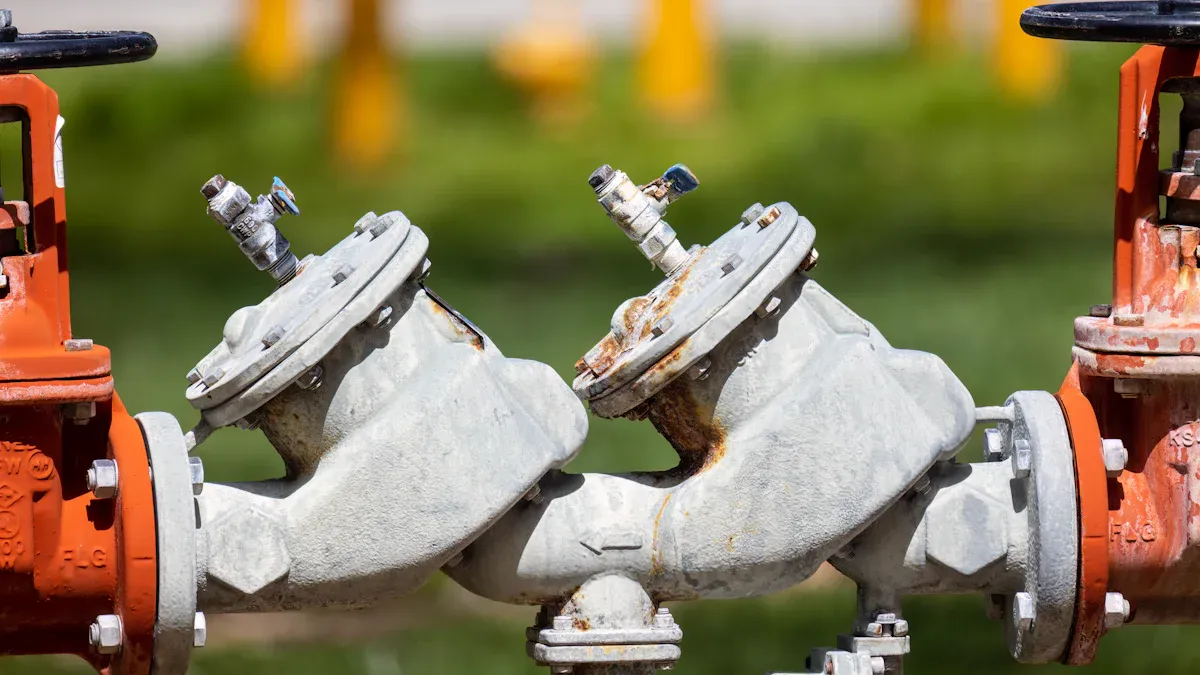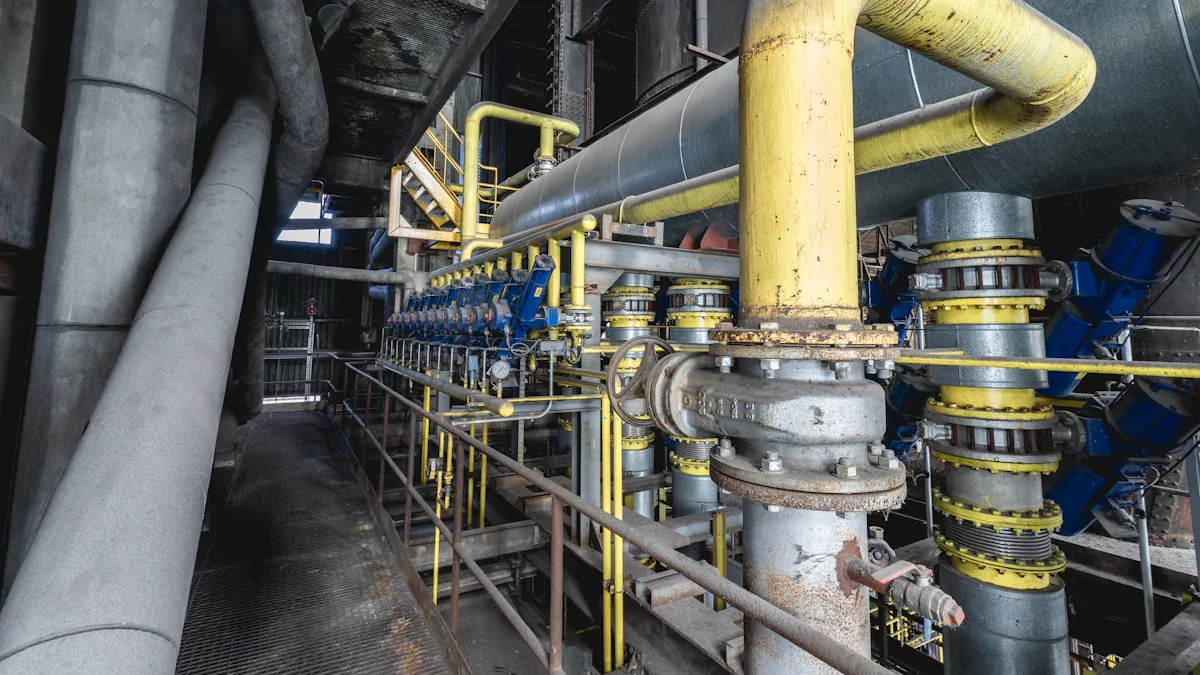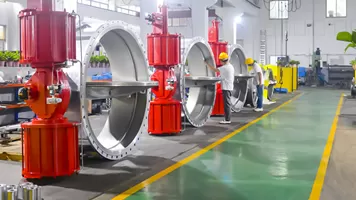
Backflow happens when water moves the wrong way, which can pull dirty water into clean water systems. This often occurs due to pressure changes and can be dangerous. For instance, a broken water pipe in Texas caused backflow and polluted the water. The town fixed this by adding backflow preventers and conducting more tests to stop it from happening again.
Backflow valves, including various backflow valve types, block dirty water from mixing with clean water. Choosing the right valve type is essential for keeping your water safe and complying with local regulations. Factors such as water pressure, risks, and system setup help determine which backflow valve types to use.
At the 1933 Chicago World’s Fair, a plumbing problem caused backflow. It polluted the water and led to over 100 deaths. This disaster made plumbing rules stricter and required backflow prevention devices.
Key Takeaways
- Backflow valves stop dirty water from mixing with clean water. This keeps drinking water safe.
- Pick the right backflow valve based on risk, location, and water pressure.
- Test and maintain backflow devices often to prevent health problems and legal trouble.
- Certified experts should install and test valves to ensure they work well and follow rules.
- Knowing about different backflow valves helps you choose the best one for your needs.
Backflow Valve Types and Their Functions

Air Gap
An air gap is a simple and effective way to stop backflow. It creates a space between the water outlet and the highest water level. This space, usually twice the pipe’s width, stops dirty water from mixing with clean water. For example, the gap between a faucet and a sink keeps dirty water out of drinking water.
Air gaps are easy to maintain and very dependable. They are often used in sinks, tanks, and other plumbing systems. Their simple design makes them great for homes and businesses that need reliable solutions.
Tip: If you want a backflow device that’s easy to care for, choose an air gap.
Atmospheric Vacuum Breaker (AVB)
An atmospheric vacuum breaker (AVB) stops backflow caused by suction. It has a valve that opens when pressure drops below normal. This lets air in to break the suction, stopping dirty water from flowing back.
AVBs cannot be tested and must be placed above the highest water outlet. They are often used in sprinklers and other low-risk systems. While useful in certain cases, they are not good for systems with constant pressure.
Pressure Vacuum Breaker (PVB)
A pressure vacuum breaker (PVB) is a flexible backflow stopper. It has a spring valve that shuts during normal flow and an air valve that opens if pressure drops. This stops suction and keeps dirty water out of clean water systems.
PVBs have test cocks for regular checks to ensure they work well. They are installed above the highest outlet and work in systems with constant pressure. Regular care is needed to keep them working properly. Rules like those from the American Water Works Association (AWWA) stress testing PVBs to keep them effective.
| Backflow Valve Type | Description | Testing Capability |
|---|---|---|
| Pressure Vacuum Breaker (PVB) | Stops backsiphonage, installed above the highest outlet. | Has test cocks for testing |
| Atmospheric Vacuum Breaker (AVB) | Non-testable, stops backsiphonage, placed above the highest outlet. | Cannot be tested |
| Air Gap | Space between water outlet and maximum water level in a container. | Cannot be tested |
Note: PVBs are perfect for sprinklers and systems needing backflow protection under constant pressure.
Double Check Valve Assembly (DCVA)
The Double Check Valve Assembly (DCVA) is a handy tool to stop backflow. It has two spring-loaded valves that block water from flowing backward. Four test valves are included for regular checks. An outlet shutoff valve helps control water flow better. Install it with at least one foot of space for easy access.
DCVAs work well in homes and businesses with low contamination risks. For example, they protect water linked to lawn sprinklers or fire sprinklers. However, they don’t stop backpressure or backsiphonage in high-risk situations.
Tip: Test DCVAs often to keep them working and follow rules.
Reduced Pressure Zone Device (RPZ)
The Reduced Pressure Zone Device (RPZ) gives the best protection against backflow. It has a relief valve that opens during pressure changes. This stops dirty water from entering clean water systems. The valve also releases water during backflow, showing there’s a problem.
RPZs are used in high-risk places like chemical or fertilizer systems. They are common in factories, cities, and businesses to keep water safe. These devices meet strict health rules from groups like the American Water Works Association.
Note: RPZs are the best choice for serious backflow risks.
Hose Bib Vacuum Breaker
A hose bib vacuum breaker is a small, low-cost backflow stopper for outdoor use. It connects to a faucet or hose bib to block backflow into the main water supply. This is helpful for garden hoses, which can carry pesticides, fertilizers, or dirty water.
Hose bib vacuum breakers are simple to set up and need little care. They are great for homeowners wanting better outdoor water safety. While not for high-risk uses, they work well for everyday needs.
Tip: Check local plumbing rules to ensure your hose bib vacuum breaker is approved.
Applications of Backflow Preventers

Residential Uses
Backflow preventers help keep your home’s water clean and safe. Simple tasks like watering plants or filling pools can cause backflow. For example, if a garden hose is left in a pool, dirty water might flow back into your drinking water. Using devices like hose bib vacuum breakers stops this from happening.
Backflow problems are rare in homes but still dangerous. In California, a neighborhood had backflow when high-pressure washers caused irrigation water to mix with clean water. This shows why backflow preventers are important, even in low-risk areas. Devices like double check valve assemblies (DCVAs) are often used in homes to stop small contamination risks.
Tip: Check and maintain your backflow preventer often to keep it working.
Commercial and Industrial Applications
Businesses and factories have more backflow risks because of complex water systems. Places like hospitals, factories, and sewage plants need strong backflow preventers to protect public health. For instance, a New York City office building had contamination when a pressure surge in its HVAC system caused backflow into drinking water.
Backflow devices in these places protect water and follow rules. The Safe Drinking Water Act requires backflow prevention, and groups like the American Water Works Association (AWWA) give advice on choosing and caring for devices.
Skipping maintenance on backflow preventers can cause health problems and legal trouble.
New technology like automatic shutoff valves makes things easier. But installing and testing these devices can still be hard. Businesses must focus on these steps to avoid contamination and meet rules.
High-Hazard vs. Low-Hazard Scenarios
The backflow preventer you need depends on your system’s risk level. High-hazard systems, like chemical plants or fire sprinklers with antifreeze, can harm health. These need advanced devices like reduced pressure zone devices (RPZs). Low-hazard systems, like home fire sprinklers, may only need simpler devices like DCVAs.
| Hazard Type | Description | Example |
|---|---|---|
| High Hazard | Systems that can add harmful substances to public water. | Fire sprinklers with antifreeze or foam systems. |
| Low Hazard | Systems that cause small water quality issues without health risks. | Fire sprinklers with stagnant water or minor corrosion. |
Knowing the difference between high and low hazards helps you pick the right device. High-hazard systems need strict measures to stop serious contamination.
Note: Always ask an expert to check your system and choose the right backflow preventer.
How to Pick the Right Backflow Preventer
Checking Location and Water Pressure
Think about your location and water pressure when picking a backflow preventer. These affect how well the device works and lasts. Too much water pressure can damage the device and cancel its warranty. Watching water pressure often can spot problems like sudden drops, which may mean leaks.
Here are key things to check:
| Factor | What to Look For |
|---|---|
| Property Features | Look at your property’s layout and how water is used. |
| Local Rules | Find out if local laws need certain backflow preventers. |
| Pressure Changes | Check if the device can handle pressure ups and downs. |
| Contamination Dangers | Spot risks of dirty water mixing with clean water. |
| Device Options | Choose between testable or non-testable devices based on risks. |
| Space and Fit | Make sure the device fits the space and setup. |
By checking these points, you can pick a backflow preventer that fits your needs and follows the rules.
Understanding Risk Levels
Knowing your water system’s risk level is key to stopping backflow. High-risk systems, like hospitals or sewage plants, need advanced devices like RPZs. Medium-risk systems, like sprinklers, might use double check valve assemblies. Low-risk systems, like homes, usually need simpler devices.
| Risk Level | Examples of Use | Suggested Device |
|---|---|---|
| High | Hospitals, sewage plants | Advanced backflow devices |
| Medium | Sprinklers, fire systems | Medium-risk devices |
| Low | Homes | Basic backflow devices |
Low-risk systems may only affect water taste, but high-risk ones can harm health. Always ask an expert to pick the right device for your system.
Comparing Costs and Maintenance
Cost and care are important when choosing a backflow preventer. While buying one may cost more at first, regular checks save money by avoiding big repairs. Testing costs $50 to $200, depending on the device and location.
Skipping maintenance can cause fines and health problems. Hiring a service provider can lower costs with discounts. Professional installation, costing $200 to $500, ensures the device works well and meets plumbing rules.
Smart backflow preventers are easy to use but may need updates and new sensors, adding to costs. Think about these factors to balance price and reliability.
Consulting Professionals for Installation and Testing
Hiring experts to install and test backflow preventers keeps water safe. Professionals know how to check your system and find risks. They can suggest the best device for your needs and install it properly. Correct installation is key for the device to work well.
Testing by professionals is just as important. Backflow preventers need regular checks to ensure they work right. Certified testers use special tools to find leaks, pressure drops, or other issues. This helps avoid expensive repairs and health risks from dirty water.
Real-life examples show why experts are needed. In Texas, a broken water pipe caused backflow. The town added more backflow preventers and stricter tests to fix it. In New York City, a building had contamination after a pressure surge. Experts installed advanced RPZ devices to stop future problems. In California, high-pressure washers caused contamination in a neighborhood. They required backflow preventers to prevent it from happening again. These cases prove that expert help protects water and health.
When hiring, choose certified plumbers or technicians with experience in backflow prevention. Many areas require licensed professionals for this work. Check reviews or ask for references to find someone trustworthy.
Tip: Regular professional testing keeps your backflow preventer working well and helps you follow local rules.
Knowing about backflow valve types helps keep water clean and safe. Problems like back pressure and back siphonage can make water dirty. Picking the right valve follows rules and protects your plumbing.
Installing, testing, and caring for valves is very important. Yearly checks find problems early and save money on repairs. Skipping these steps can cause health dangers and legal trouble. Cities follow rules like the Safe Drinking Water Act to keep water safe.
Hiring trained experts ensures proper setup and follows the rules. Their skills make sure your backflow preventer works well, keeping your water safe and worry-free.
Tip: Taking care of your valve protects water and public health.
FAQ
What do backflow valves do?
Backflow valves stop dirty water from mixing with clean water. They keep your water safe from pollution caused by pressure changes. These valves are important for homes, businesses, and factories to have clean water.
How does a backflow device work?
A backflow device blocks water from flowing the wrong way. It uses parts like check valves or air gaps to stop dirty water. Testing it often makes sure it works properly.
When should you use a double check valve?
Use a double check valve for low or medium-risk systems. It’s good for things like lawn sprinklers or fire sprinklers. This valve stops backpressure and backsiphonage effectively.
What are reduced pressure valves for?
Reduced pressure valves are for high-risk systems. They protect against serious contamination in places like hospitals or chemical plants. These valves release water during backflow to keep pollutants out.
Can dual check valves be used at home?
Yes, dual check valves are great for homes. They give basic protection for low-risk systems like household plumbing. They are affordable and easy to take care of for daily use.

